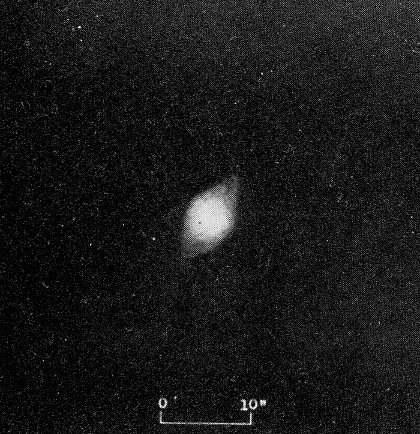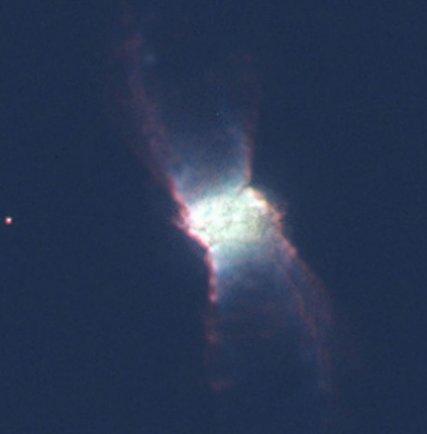NGC 6881
Curtis only hints at the structure and the confusion attendant on
NGC 6881, a visually tiny planetary
nebula in a crowded region of central Cygnus 3.5 degrees southwest of Sadr (Gamma Cygni). He says: "Probably has a
central star" (indeed, see below). As to the nebula, "Just
distinguishable from a star; a minute disk 5 [seconds of arc] in
diameter, with very faint ansae." In the Hubble image at right
(rotate about 60 degrees to the right for a match), the "ansae,"
more like extensive wings than the bullets of NGC 7009, grow to five times the dimension of
Curtis's inner nebula looking more like those of the "Red Spider,"
NGC 6537. The distance, as for most such
nebulae, is pretty-much unknown. A trio of estimates averages 8000
light years, but that should not be taken too seriously. Given
that figure, the inner nebula is 0.2 light years across, the outer
wings a full light year from one end to the other. Notice the
reflective symmetry. How one side knows what the other is doing is
not known, but possibly involves binary-star action at the
center, which stirs the mass loss from the progenitor advanced giant star. Chemical
abundances seem normal, though there is some indication of enriched
helium.
There are three divergent values for the brightness of the central
star: a visual magnitude of 16.7 (which, compared with the nebular
radiation gives a core temperature of 77,000 Kelvin), another of
18.4 (100,000 K), and an estimate purely from the nebular spectrum of 20.5 (143,000
K), the last probably not realistic, the differences vividly
showing the difficulty of detecting a faint star against a bright
background. The brighter of the two remaining values and the poor
distance suggests a stellar luminosity around 7000 Suns and a core mass a bit over 0.6 solar, the
star still heating. That will be the mass of the final white dwarf once the nebula
(the inner portion expanding at 17 kilometers per second)
dissipates into the darkness of space.
Left: Image by H. D. Curtis from Publications of the Lick
Observatory, Volume 13, Part III, 1918. Right: Hubble image by J.
Schulman and the ESA/ESO/NASA Photoshop FITS Liberator.



